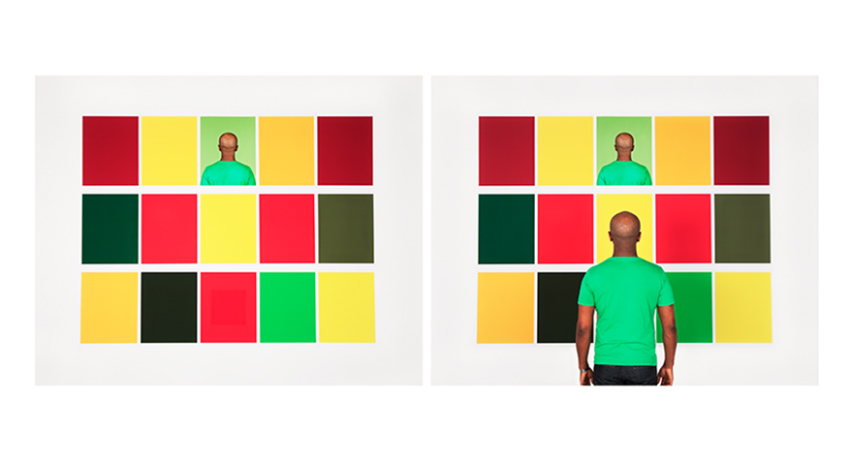‘Sense of Place’ Exhibit at the MFA Marks Homecoming for Dawit L. Petros

“Colorscape, Coordinate #23, Ethiopia” by Dawit L. Petros. (Photo courtesy of Dawit L. Petros and Museum of Fine Arts, Boston)
In a new video installation in the Edward H. Linde Gallery at the Museum of Fine Arts, a figure in blue workman’s overalls traverses through four Boston neighborhoods, with a barella—a cart used by construction workers in Africa—in tow.
The video, alongside photographs, painted wall murals, and sculptures, comprises “Sense of Place,” a new MFA exhibit in which artist Dawit L. Petros explores the specificity of place through works that challenge traditional views of abstraction.
In a way, “Sense of Place” marks a homecoming for Petros—he received his Masters degree from the School of the Museum of Fine Arts in 2007. This exhibit serves as the culmination of a larger project he had been working on since 2009.
“To come back [to Boston] as a working artist was markedly different. I was dealing with a lot of institutions—the school, the museum—that I had had a relationship with, but always in the role of a student,” said Petros in a phone interview. “When it came down to the work, the challenge was to bring all these experiences that I’ve cultivated through this particular project to Boston, but not simply replicate the project that I had done iterations of in different parts of the world so that it became formulaic.”
The exhibit encompasses works based on Petros’s travels to a number of locations over the past few years—Harlem, where the project began in 2009; Osbourne, Kansas; Addis Ababa, Ethiopia; Dakar, Senegal; São Paul, Brazil; and now, his return to Boston.
Petros takes “walks of discovery” at each location, charting courses through specific neighborhoods and photographing colored objects he encounters along the way, ranging from doorways to trash bags to traces of graffiti-colored walls. Then, in the studio, he abstracts the photographs to generate monochromatic fields of color, which he then uses to create new photographs, sculptures, vinyl wallpaper, and custom latex paint murals—”Social Abstractions,” as he calls them.
In the case of Boston, the four neighborhoods featured in the video were chosen based on both Petros’s personal experiences within them and their significance within the city’s historical context and the artist’s larger project. He lived in Jamaica Plain while attending SMFA in Fenway; the waterfront plays an integral part in Boston’s identity and the history of American expansion; and Roxbury’s demographics are similar to those of Harlem, where the project began.
Petros hopes that the exhibit—particularly the video element—will especially resonate with viewers from Boston.
“There’s a specificity to each location that appears in the video and photographs. Because of the relationship that they have [with the city], Boston viewers will be able to grasp and understand that,” he said. “But what I then want them to do is to recognize and question their proximity to these other places like Osbourne, Kansas, and Addis Ababa, Ethiopia. Each work attempts to integrate the Boston viewer into multiple physical and cultural spaces by offering alternative strategies for reading and writing one’s relationship to a place.”
The exhibit’s location in Boston also particularly resonates with Petros himself.
“There’s something about returning to Boston,” he said. “This is my first solo museum exhibition and for it to happen at an institution that I have a relationship with, it does make a nice circle back.”
But although the homecoming feels conclusive for Petros in terms of this particular project, it is by no means conclusive in regard to the methodology with which he approaches art.
“I’m not leaving questions of abstraction or the mode of working, but the idea of the work [becoming a] formula that can be applied everywhere is one that frightens me—it seems overly determined,” he said. “I’m getting to the point now where I have to propose new challenges and follow that line of inquiry and see where it goes. This project feels as though it ended up where it was meant to end up, and now it’s liberating me to go ask different questions.”
“Dawit L. Petros: Sense of Place” is on view at the Edward H. Linde Gallery in the Museum of Fine Arts until April 13, 2014. For more information, visit mfa.org.


